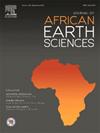Phase relations in Co-Ni-Fe-(±Au ±Ag) mineralizations of Bou Azzer-El Graara inlier, central Anti-Atlas, Morocco: Insights from mineral chemistry and fluid inclusions analysis
IF 2.2
4区 地球科学
Q2 GEOSCIENCES, MULTIDISCIPLINARY
引用次数: 0
Abstract
The Bou Azzer East deposit is located in the western part of the Bou Azzer inlier, where many orebodies of Co-Ni-Fe ± Au ± Ag are actively mining. These orebodies are mainly controlled by late Pan-African and/or Hercynian structures. The Co–Ni arsenide-sulfarsenide mineralization at Bou Azzer East is associated with serpentinite rocks, and possesses two modes of occurrence: (i) at the contact between serpentinite and quartz diorite or Ediacaran volcanic rocks, with veins sometimes extending into serpentinite; (ii) as orebodies crosscutting quartz diorite (vein-type). The Bou Azzer Co-Ni mineralization proposed to be formed by three stages: (1) pre-mineralization stage, characterised by the presence of chromite and talc; (2) arsenide mineralization stage (mono-, di-, tri-arsenides and sulfarsenides) associated with quartz gangue; and (3) sulphide mineralization stage accompanied by carbonate gangue. These stages of mineralization are temporally arranged and separated by brittle deformation episodes. Except for the first stage, inclusions of native-Au and electrum (Au-Ag) are found in the subsequent stages of arsenides, sulfarsenides, and sulphides. Native-Au is also emphasized in the supergene stage. Micrometric analysis of fluid inclusions (FI) was carried out on quartz and calcite gangues. FI trapped in quartz show that arsenides and Au-Ag mineralization precipitated from hydrothermal fluids at temperatures ranging from 200 to 350 °C and salinities ranging from 15 to 45wt% NaCl equiv. The sulphide and Au-Ag assemblage, hosted in calcite gangue, is most probably formed from fluids with temperature ranging from 200 to 250 °C and salinities between 25 and 45 wt% NaCl equiv. The precipitation of the ore minerals is related to fluid mixing, boiling, and cooling at different temperatures and salinities. Weathering of hypogene arsenides and sulphides minerals led to the formation of heterogeneous secondary minerals, including erythrite, roselite, chalcocite, bornite, and native gold. This phenomenon, driven by leaching and fluid-rock interactions, contributed to the formation of these secondary minerals.
求助全文
约1分钟内获得全文
求助全文
来源期刊

Journal of African Earth Sciences
地学-地球科学综合
CiteScore
4.70
自引率
4.30%
发文量
240
审稿时长
12 months
期刊介绍:
The Journal of African Earth Sciences sees itself as the prime geological journal for all aspects of the Earth Sciences about the African plate. Papers dealing with peripheral areas are welcome if they demonstrate a tight link with Africa.
The Journal publishes high quality, peer-reviewed scientific papers. It is devoted primarily to research papers but short communications relating to new developments of broad interest, reviews and book reviews will also be considered. Papers must have international appeal and should present work of more regional than local significance and dealing with well identified and justified scientific questions. Specialised technical papers, analytical or exploration reports must be avoided. Papers on applied geology should preferably be linked to such core disciplines and must be addressed to a more general geoscientific audience.
 求助内容:
求助内容: 应助结果提醒方式:
应助结果提醒方式:


